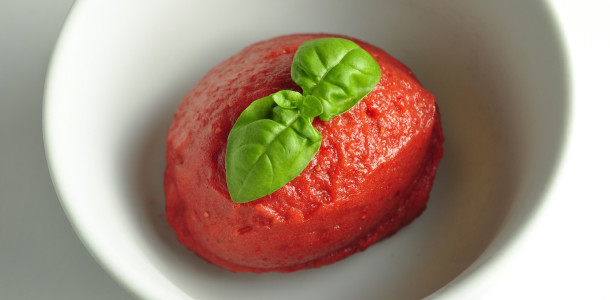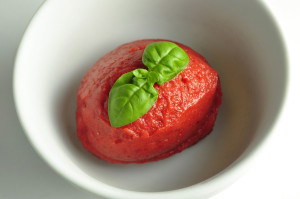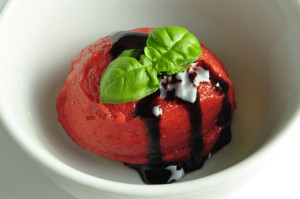Looking at the image of this sorbet, you might suppose that either it has been Photoshopped to appear very red, or some sort of food dye has been added to the mixture. In fact, neither has occurred. The deep rich color is the result of two factors: (1) perfect, ripe organic strawberries and (2) no sugar syrup added.
The normal recipe for making a sorbet typically includes “simple syrup,” which is made by combining sugar and water in a saucepan, bringing it to a boil, and simmering it until the sugar has fully dissolved and the mixture is clear. This sweetens the sorbet, but it also waters down the flavor—and the color—to some degree, depending on the intensity of the fruit being used. Most strawberry sorbets have a somewhat pale, pinkish red color for this reason. This one, you will find, has an intense, bright, fresh strawberry flavor and texture to match the Ferrari-red color.
For this sorbet, I used no simple syrup at all, and just a little evaporated organic cane juice for sweetener. It is essentially a frozen strawberry purée. I also added a little lemon juice, blood orange extra-virgin olive oil “agrumato” *, and aged balsamic vinegar**. While the oil and vinegar are comparatively minor and not absolutely essential to the success of the sorbet, they add specific elements that give the final result unique qualities. You won’t really taste them—or the lemon juice—but they provide balance, depth and subtle aromatics.
Aside from washing, drying and hulling the strawberries, this is ridiculously quick and easy to make.
Strawberry Sorbet with Basil
Makes about 3 1/2 cups
1 pound ripe organic strawberries
1/4 cup evaporated cane juice crystals (a.k.a. organic cane sugar)
2 tablespoons freshly squeezed lemon juice
1 tablespoon blood orange agrumato (see note, below)
1 teaspoon 18 year old aged balsamic vinegar (see note, below)
4 small basil leaves (optional)
Wash the strawberries very quickly (they are quite porous, and will absorb the water if exposed to it more than briefly). Spread them out on a towel and place another towel on top. Press gently on the towel to dry the strawberries, and then cut out the stems with a paring knife, along with any whitish areas in the cores.
Put the strawberries in a food processor and add all the remaining ingredients. Process until smooth. Some tiny seeds will remain, and will provide a slightly gritty but agreeable strawberry texture. Transfer the purée to a bowl, cover, and refrigerate until cold, about 2 hours.
Pour the mixture into an ice cream machine and freeze according to the manufacturer’s instructions. The sorbet will have a marvelous silky texture if served immediately, but if you prefer, scrape it into a cold container and store in the freezer.
Remove the container from the freezer 15 to 20 minutes before serving, allowing the sorbet to soften slightly. Serve at once, garnished with small basil tops. You may also like to drizzle a little of the aged balsamic over the sorbet before adding the basil tops, giving the dessert an additional layer of flavor.
* An “agrumato” is made by crushing citrus fruits (in this case, blood oranges) along with the olives, infusing the resulting extra-virgin olive oil with the flavor of the citrus. If you live in the Colorado Springs area (or in Sarasota or Venice, Florida), you can obtain an excellent blood orange agrumato at Venice Olive Oil Co.
If you don’t have access to blood orange agrumato, substitute with a good extra-virgin olive oil. The blood orange flavor will not be there, but the other benefits of the olive oil will.
**”Aged balsamic vinegar” is a bit redundant, because true balsamic vinegar is aged, for at least ten years, in wood casks of decreasing size. The older the balsamic, the more expensive. There is a cheat, however, which is very easy to produce. I have a recipe for it in Extraordinary Vegan, but it’s so simple: just simmer a commercial “balsamic vinegar” until reduced by a little less than half its original volume. It will become syrupy and slightly sweetened. Be careful not to reduce it too much, or it will acquire a slightly off-putting molasses taste. This is by no means even vaguely the same as a genuinely aged balsamic, and it will lack nearly all of its qualities, but for some uses, it will make an acceptable stand-in.











